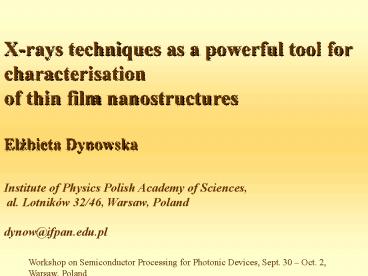Prezentacja programu PowerPoint - PowerPoint PPT Presentation
1 / 25
Title:
Prezentacja programu PowerPoint
Description:
X-rays techniques as a powerful tool for characterisation. of thin ... polycrystalline ZnO on sapphire and quartz. ZnO:N by oxidation of Zn3N2. microstructure ... – PowerPoint PPT presentation
Number of Views:40
Avg rating:3.0/5.0
Title: Prezentacja programu PowerPoint
1
X-rays techniques as a powerful tool for
characterisation of thin film nanostructures
Elzbieta Dynowska
Institute of Physics Polish Academy of
Sciences, al. Lotników 32/46, Warsaw,
Poland dynow_at_ifpan.edu.pl
Workshop on Semiconductor Processing for Photonic
Devices, Sept. 30 Oct. 2, Warsaw, Poland
2
Outline
1. Introduction 2. Basics ? General
information about nanostructures ? What we want
to know about thin layers? ? How to get this
information? 3. Selected X-ray techniques ?
X-ray reflectivity ? X-ray diffraction 4.
Synchrotron radiation new possibilities 5.
Summary
3
Thin layer the dimension in the z-direction is
much smaller than in the x
and y, respectively.
z
y
x
0
single crystal thin layer having
the crystal structure and
orientation of single crystal
substrate on which it was grown.
(A) Epitaxial layer
x
Homoepitaxial layer the layer and
substrate are the same material
(the same lattice
parameters). Heteroepitaxial layer the
layer material is different than the
substrate one
(different lattice parameters).
4
Lattice mismatch
f (alayer - asubs )/ asubs
Critical thickness hc
thickness below which the
layer grows
pseudomorphically the cubic unit
cell of
layer material is tetragonally distorted
alz ? alx
aly as (the layer is fully strained).
hc decreasing when f
increasing. Layer relaxation - alxy
alz al relax abulk
(B) Polycrystalline layers
orientations of small
crystallites are
randomly distributed with respect to
layer
surface
(C) Amorphous layers - lack of
long-distance ordering of atoms
5
- What we want to know about thin layers?
- ? Crystalline state of layer/layers
- (epitaxial? polycrystalline? amorphous? )
- ? crystal quality
- ? strain state
- ? defect structure
- ? chemical composition (in the case of ternary
compounds layers) - ? thickness
- ? surface and interface roughness, and so on
6
How to get this information?
By means of X-ray techniques
Why?
Because X-ray techniques are the most important,
non-destructive methods of sample
characterization
7
Selected X-ray techniques
? X-ray reflectivity
Small-angle region Refraction index for X-rays n
lt 1 Roughness investigation
n 1- ? i?
? 10-5 in solid materials (10-8 in air) ? -
usually much smaller than ?.
z
2?i
x
Si rough wafer - simulation
Layer thickness determination
The distance between the adjacent interference
maxima can be approximated by ??i ? ?/ 2t
8
Example superlattice
Si/Fe/Fe2Nx28/GaAs(001)
Results of simulation
Experiment
Simulation
10.4 nm
Intensity
?? (2?) - superlattice period
126.6nm
28 times repeated
All superlattice
4.52nm
?? (2?) cap-layer
?c?0.3
?i (deg)
9
? X-ray diffraction wide-angle
region
Braggs law
n? 2dsin? d/n d
? ? ? ? ? ? ? ? ? ? ? ?
?
? ? ? ? ? ? ? ? ? ? ? ?
?
? 2d sin?
? ? ? ? ? ? ? ? ? ? ? ?
?
? ? ? ? ? ? ? ? ? ? ? ?
?
10
Geometry of measurement
?/2? coupling
?/2? coupling
11
Possibilities
? Crystalline state of layer/phase
analysis
MnTe/Al2O3
ZnMnTe/MnTe/Al2O3
CuK?1 radiation
FeK? radiation
12
? Crystal quality
Rocking curve
Detector
21 arcsec
112 arcsec
Lattice parameter fluctuations
?
Mosaic structure
13
? Strain state defect structure
Strain ? tetragonal deformation of cubic unit
cell
Pseudomorphic case
Cubic unit cell of layer material
az ? ax ay asub
az
Partially relaxed
ay
ax
Cubic unit cell of substrate
az ? ax ay ? asub
alayer
Relaxed
az ax ay alayer
14
The reciprocal lattice maps
Reciprocal lattice
The sample orientation can be described by two
vectors P - vector which is the direction normal
to the sample surface S any other vector which
is not parallel to the P vector and lies in the
horizontal plane.
H102 1/d102
S 100
pseudomorphic
Mosaic structure
15
Examples
In0.50Al0.50As/InP
004
004
Symmetric case
(a)
(b)
224
224
Asymmetric case
For cubic system
For tetragonal system
16
? chemical composition
If AB and CB compounds having the same
crystallographic system and space group create
the ternary compound A1-xCxB then its lattice
parameter a ACB depends linearly on x-value
between the lattice parameters values of AB and
CB, respectively.
Vegards rule
In the case of thin layers arelaxed must be
taken for chemical composition determination from
Vegards rule
aCB
aAB
c12, c11 elastic constants of layer material
17
Heterostructure ZnMnxTe/ZnMnyTe/ZnMnzTe/ZnTe/
GaAs
004 rocking curve
ZnTe
004
x
y
z
004 ?/2?
335
relaxed
pseudomorphic
18
Towards an ohmic contacts
Ti/TiN/GaN/Al2O3 under annealing
Secondary Ion Mass Spectrometry (SIMS)
XRD
19
NbN/GaN/Al2O3
(SIMS)
XRD
(SIMS)
XRD
20
Deposition of Zn3N2 by reactive rf sputtering
Zn3N2
20 N2 ?Zn3N2 Zn
25 N2? polycryst. Zn3N2
N2gt80 polycryst. amorph.
50 - 70 N2? monocryst.
21
ZnON by oxidation of Zn3N2 microstructure
highly textured ZnO on GaN and ZnO
22
ZnO by oxidation of ZnTe/GaAs
XRD
(SIMS)
Te inclusions in ZnO film
23
Synchrotron radiation
24
Example superlattice of self-assembled
ultra-small Ge quantum dots
Results HREM XRD
superlattice period C.....? 33.5 nm 33 nm,
thickness of Ge............... ?
1.8 nm 2.0 nm thickness of SiGex bottom
layer..................... ? 6.7 nm 6.7 nm
Compositon........................ ----
x ? 0.2
7 times repeated
C
Si, 2nm, 250 C
Ge, 1nm, 250 C
50nm
High resolution electron microscopy (HREM)
JEOL-4000EX (400 keV)
Hasylab (Hamburg), W1.1 beamline
XPert Epitaxy and Smoothfit software
Si 004
Ge 004
? 2? 0.314o
-1
-2
Si0.8Ge0.2 bottom layer
Experimental diffraction pattern
Simulated diffraction pattern
25
Acknowledgements I would like to express my
gratitude to my colleagues for their kind help
Eliana Kaminska Jarek Domagala Roman
Minikayev Artem Shalimov































